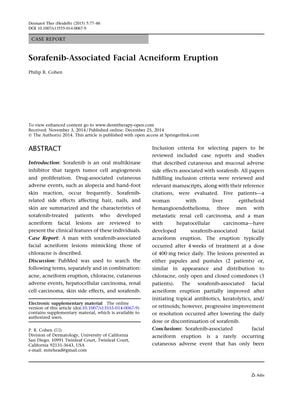TLDR Sorafenib can cause facial acne-like eruptions, which improve after reducing the dose or stopping the drug.
Sorafenib, an oral multikinase inhibitor, was associated with facial acneiform eruptions in five patients, typically appearing after 4 weeks of treatment at a dose of 400 mg twice daily. The eruptions resembled chloracne in three patients and presented as papules and pustules in two others. Topical treatments provided partial improvement, but significant improvement or resolution occurred after reducing the dose or discontinuing sorafenib. This cutaneous adverse event was rare and observed in patients with various cancers, including liver epithelioid hemangioendothelioma, metastatic renal cell carcinoma, and hepatocellular carcinoma.
11 citations
,
December 2013 in “Clinical and Experimental Dermatology” Sorafenib often causes skin side effects, indicating effective cancer treatment.
13 citations
,
June 2008 in “International Journal of Dermatology” Sorafenib can cause a unique skin reaction.
 192 citations
,
January 2015 in “Journal of the American Academy of Dermatology”
192 citations
,
January 2015 in “Journal of the American Academy of Dermatology” Targeted cancer therapies often cause serious skin problems that need careful management.
Low-dose sorafenib can cause severe facial acne, treatable with topical medication.
 42 citations
,
April 2012 in “Seminars in Oncology”
42 citations
,
April 2012 in “Seminars in Oncology” Targeted cancer therapies often cause skin problems that need careful management to improve patient quality of life and treatment success.
 19 citations
,
October 2011 in “Clinics in Dermatology”
19 citations
,
October 2011 in “Clinics in Dermatology” New chemotherapy drugs cause skin side effects, but treatments like minocycline and tetracycline can help reduce them.
 January 2018 in “Springer eBooks”
January 2018 in “Springer eBooks” Cancer treatments targeting specific cells often cause skin, hair, and nail problems, affecting patients' lives and requiring careful management.




